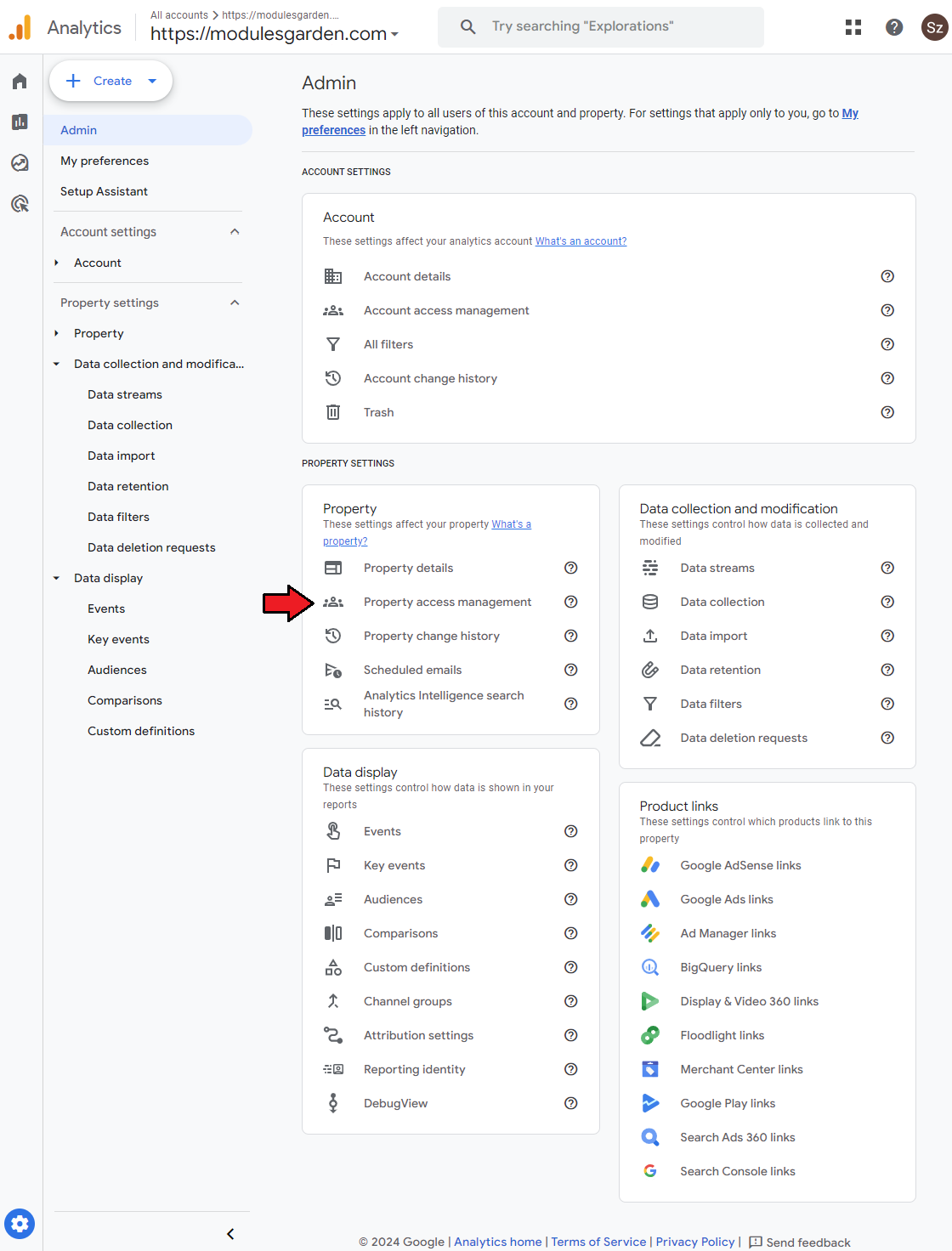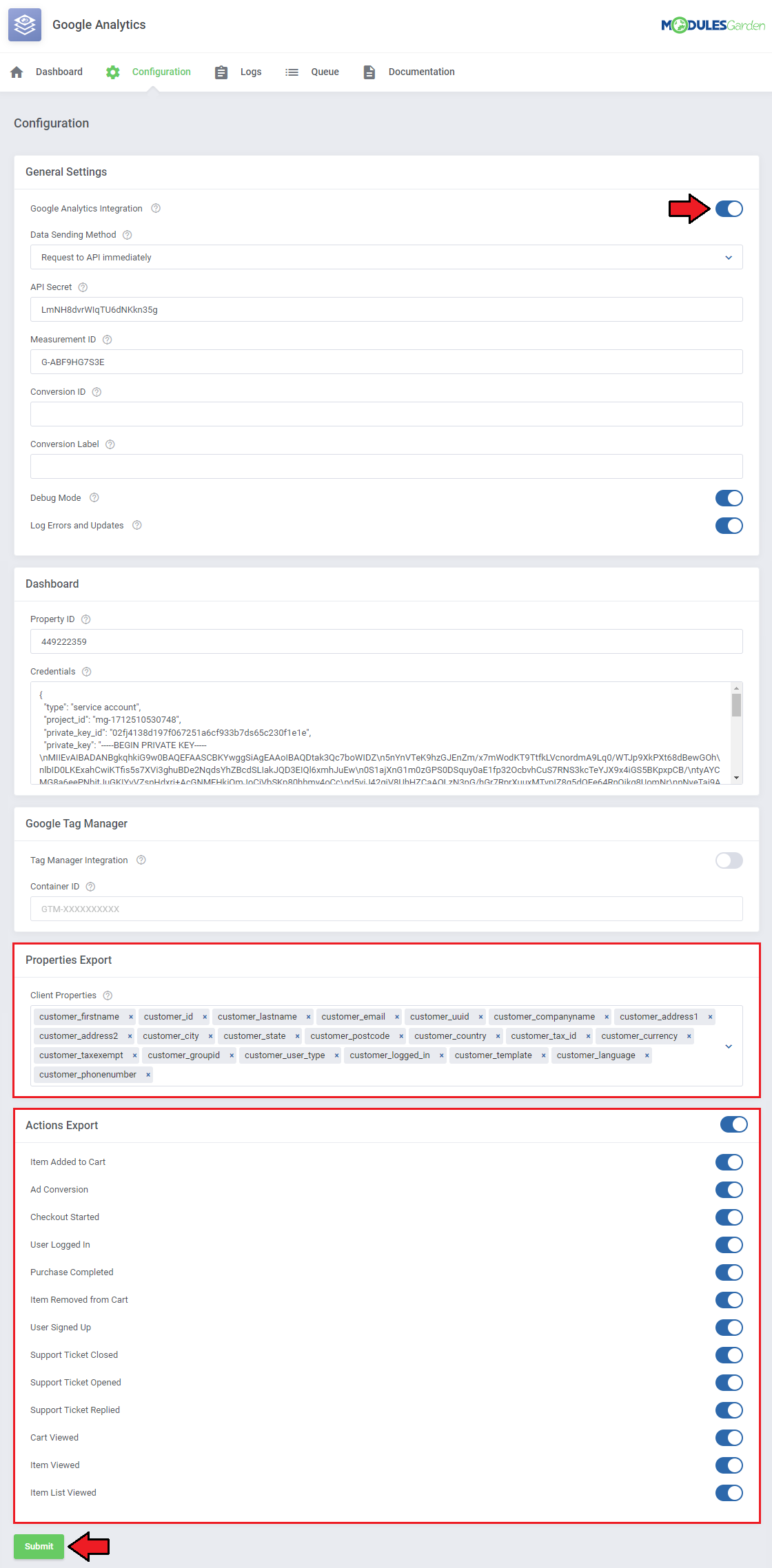Google Analytics For WHMCS
(→API Configuration and Management) |
(→Connection and API Configuration) |
||
| Line 177: | Line 177: | ||
=Connection and API Configuration= | =Connection and API Configuration= | ||
{| | {| | ||
| − | |style="padding: 10px 0px 15px 15px;"|'''7. | + | |style="padding: 10px 0px 15px 15px;"|'''7. Log in to <a href="https://analytics.google.com/" target="_blank">Google Analytics</a> and create an account for your website if you have not already.''' |
| − | + | ||
|} | |} | ||
{| | {| | ||
| − | |style="padding: 0px 0px 20px 15px;"|'''8. | + | |style="padding: 0px 0px 20px 15px;"|'''8. Copy the '' 'Measurement ID' '' and '' 'API Secret' ''.''' |
|} | |} | ||
{| | {| | ||
| Line 187: | Line 186: | ||
|} | |} | ||
{| | {| | ||
| − | |style="padding: 0px 0px 15px 15px;"|'''9. | + | |style="padding: 0px 0px 15px 15px;"|'''9. Paste them in under '' 'General Settings'.''''' |
| − | + | ||
|} | |} | ||
{| | {| | ||
| Line 194: | Line 192: | ||
|} | |} | ||
{| | {| | ||
| − | |style="padding: 0px 0px 15px 15px;"|'''10. | + | |style="padding: 0px 0px 15px 15px;"|'''10. Go to '' 'Property details' '' and find the '' 'Property ID' ''.''' |
|} | |} | ||
{| | {| | ||
| Line 200: | Line 198: | ||
|} | |} | ||
{| | {| | ||
| − | |style="padding: 0px 0px 20px 15px;"|'''11. | + | |style="padding: 0px 0px 20px 15px;"|'''11. Copy it into the respective field under '' 'Dashboard' ''.''' |
|} | |} | ||
{| | {| | ||
| Line 206: | Line 204: | ||
|} | |} | ||
{| | {| | ||
| − | |style="padding: 0px 0px 20px 15px;"|'''12. | + | |style="padding: 0px 0px 20px 15px;"|'''12. Visit <a href="https://developers.google.com/analytics/devguides/reporting/data/v1/quickstart-client-libraries#step_1_enable_the_api" target="_blank">Google Analytics Developer Site</a>. |
|} | |} | ||
{| | {| | ||
| Line 212: | Line 210: | ||
|} | |} | ||
{| | {| | ||
| − | |style="padding: 0px 0px | + | |style="padding: 0px 0px 20px 15px;"|'''13. Click on <b>Enable the Google Aanalytics Data API v1. |
| − | + | ||
| − | + | ||
| − | + | ||
| − | + | ||
| − | + | ||
| − | + | ||
| − | + | ||
|} | |} | ||
{| | {| | ||
| − | |style="padding: 0px 0px 20px 25px;"|[[File: | + | |style="padding: 0px 0px 20px 25px;"|[[File:GA_9.png]] |
|} | |} | ||
{| | {| | ||
| − | |style="padding: 0px 0px 20px 15px;"|'''14. | + | |style="padding: 0px 0px 20px 15px;"|'''14. Download your credentails.json file. |
|} | |} | ||
{| | {| | ||
| − | |style="padding: 0px 0px | + | |style="padding: 0px 0px 20px 25px;"|[[File:GA_10.png]] |
|} | |} | ||
{| | {| | ||
| − | |style="padding: 0px 0px | + | |style="padding: 0px 0px 20px 15px;"|'''15. Copy and paste its contents into the Credentials field. |
| − | + | | | |
| − | + | {| | |
| + | |style="padding: 0px 0px 20px 25px;"|[[File:GA_11.png]] | ||
| + | |} | ||
| + | {| | ||
| + | |style="padding: 0px 0px 20px 15px;"|'''16. Find client_email and copy the address. | ||
|} | |} | ||
{| | {| | ||
| − | |style="padding: 0px 0px | + | |style="padding: 0px 0px 20px 25px;"|[[File:GA_12.png]] |
|} | |} | ||
{| | {| | ||
| − | |style="padding: 0px 0px 20px 15px;"|''' | + | |style="padding: 0px 0px 20px 15px;"|'''17. Go back to <a href="https://analytics.google.com/" target="_blank">Google Analytics</a>.<br/> |
| + | Select Admin.<br/> | ||
| + | Find Account access management under Account.<br/> | ||
| + | Use the copied email to create a new user.<br/> | ||
|} | |} | ||
{| | {| | ||
| − | |style="padding: 0px 0px | + | |style="padding: 0px 0px 20px 25px;"|[[File:GA_12.png]] |
|} | |} | ||
Revision as of 13:56, 9 July 2024
Contents |
About Google Analytics For WHMCS
| Google Analytics For WHMCS integrates your WHMCS data into Google Analytics, providing deep insights into customer behavior and engagement. Access a wide range of client activities, from shopping cart actions to account interactions and support ticket changes, all within your Google Analytics account. Use this powerful module to unlock actionable insights! |
- Admin Area Features:
| ✔ Track WHMCS User Actions With Google Analytics Integration: |
| ✔ Add To Cart |
| ✔ Ads Conversion |
| ✔ Begin Checkout |
| ✔ Log in |
| ✔ Purchase |
| ✔ Remove From Cart |
| ✔ Sign Up |
| ✔ Ticket Close |
| ✔ Ticket Open |
| ✔ Ticket Reply |
| ✔ View Cart |
| ✔ View Item |
| ✔ View Item List |
| ✔ View Dashboard Statistics: |
| ✔ Events Statistics |
| ✔ New Users |
| ✔ Active Users |
| ✔ Page Views |
| ✔ Configure Google Analytics Integration: |
| ✔ Enable Integration: |
| ✔ Choose Data Sending Method: |
| ✔ Requests To API Immediately |
| ✔ Add Requests To Cron Queue |
| ✔ Provide API Secret |
| ✔ Provide Measurement ID |
| ✔ Provide Conversion ID And Conversion Label |
| ✔ Enable Debug Mode |
| ✔ Log Errors And Information |
| ✔ Enable Google Tag Manager Integration |
| ✔ Select Client Properties Send To Google Analytics |
| ✔ View And Manage Queue Tasks |
| ✔ View Module Logs |
- General Info:
| ✔ Multi-Language Support |
| ✔ Supports Google Analytics 4 |
| ✔ Supports PHP 8.1 Back To PHP 7.4 |
| ✔ Supports WHMCS V8.10 Back To WHMCS V8.8 |
| ✔ Requires ionCube Loader V12 Or Later |
| ✔ Easy Module Upgrade To Open Source Version |
Installation
| This tutorial will show you how to successfully install and authenticate Google Analytics For WHMCS. We will guide you step by step through the whole installation and authentication process. |
| 1. Log in to our client area and download the module. |
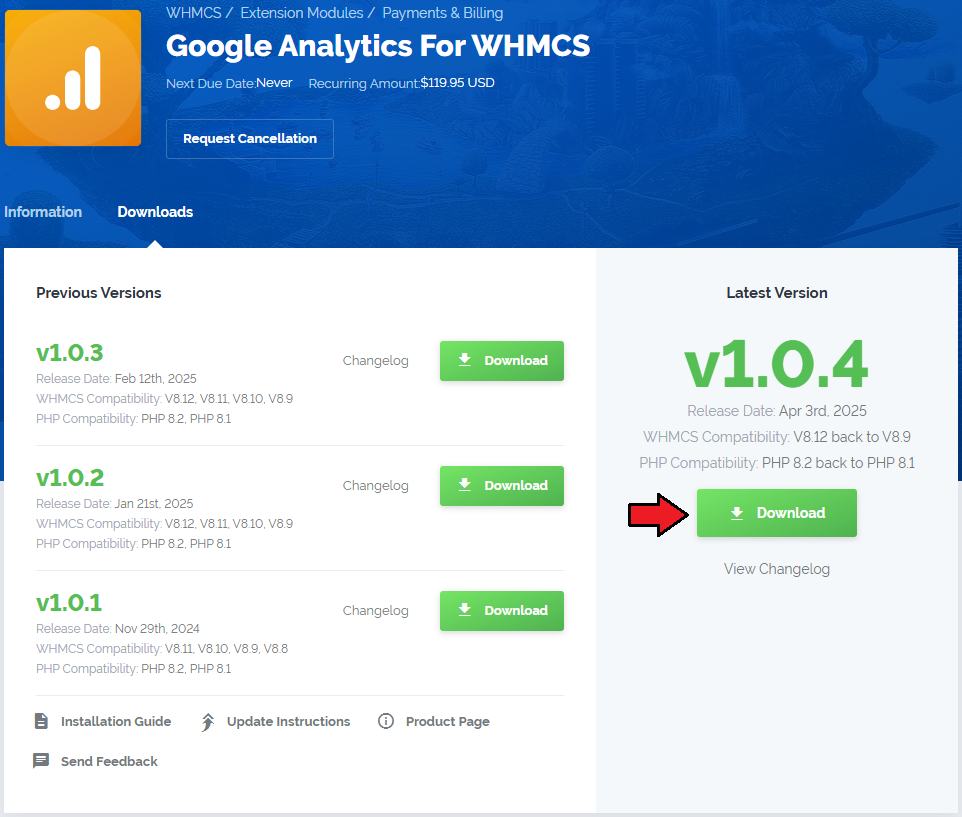
|
| 2. In the downloaded file you might find one or two packages that support different PHP versions. In the most recent versions of the module, you will find only one package that supports PHP 7.2 and later. |
| 3. Extract the package and upload its content into the main WHMCS directory. The content of the package to upload should look like this. |
| 4. When you install Google Analytics For WHMCS for the first time, you have to rename the 'license_RENAME.php' file. The file is located in 'modules/addons/googleanalytics/license_RENAME.php'. Rename it from 'license_RENAME.php' to 'license.php'. |
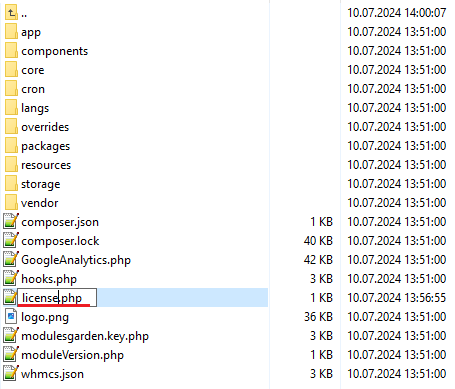
|
| 5. In order to configure your license key you have to edit the previously renamed 'license.php' file. Enter your license key between the quotation marks as presented on the following screen. You can find your license key in our client area → 'My Products'. |

|
6. Optionally, add a cron job as shown below (5-minute intervals are recommended).
php -q /your_whmcs/modules/addons/GoogleAnalytics/cron/cron.php queue This cron makes sure data is sent automatically when using the 'Add Requests to Cron Queue' Data Sending Method. |
Connection and API Configuration
| 7. Log in to <a href="https://analytics.google.com/" target="_blank">Google Analytics</a> and create an account for your website if you have not already. |
| 8. Copy the 'Measurement ID' and 'API Secret' . |
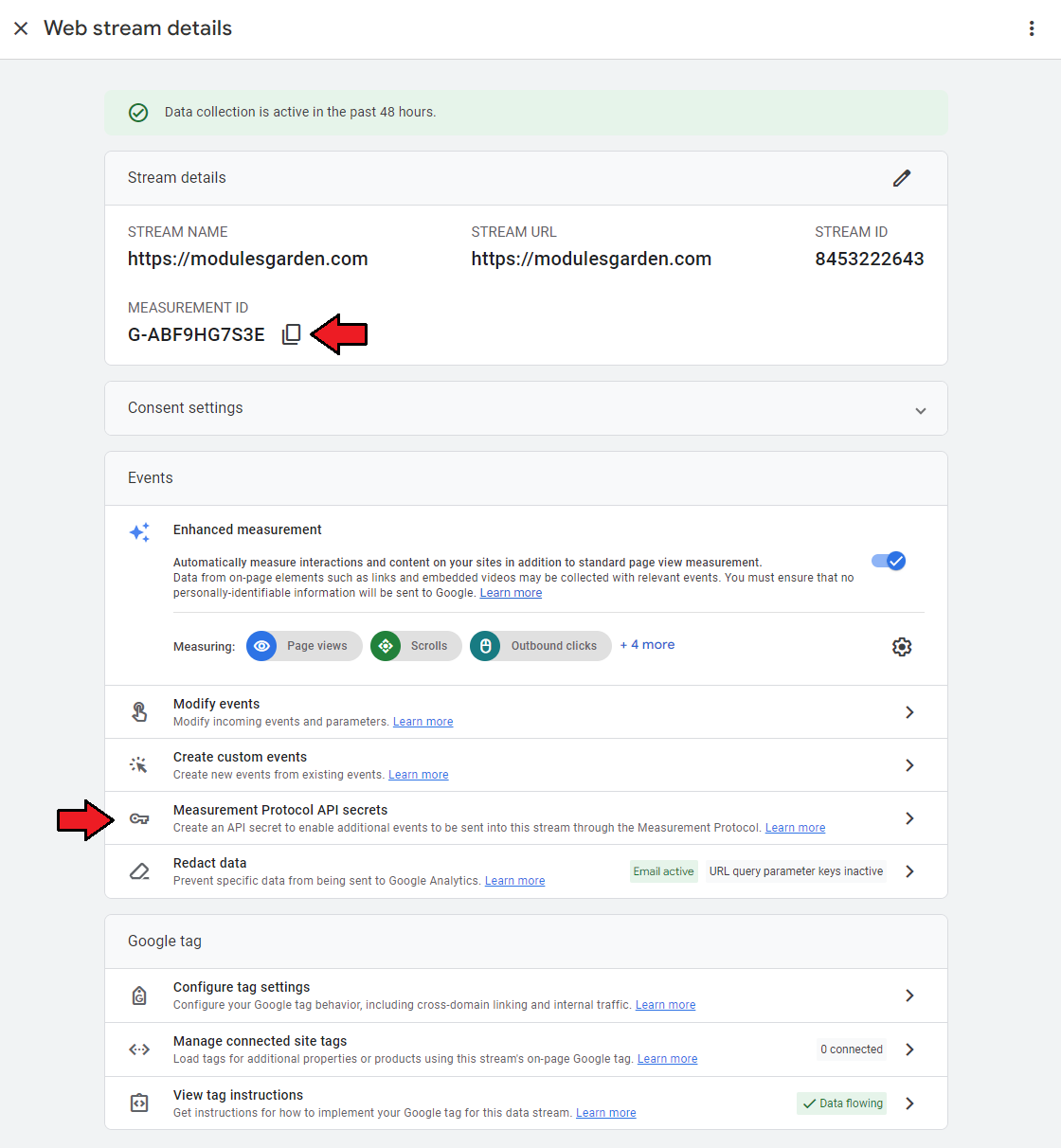
|
| 9. Paste them in under 'General Settings'. |
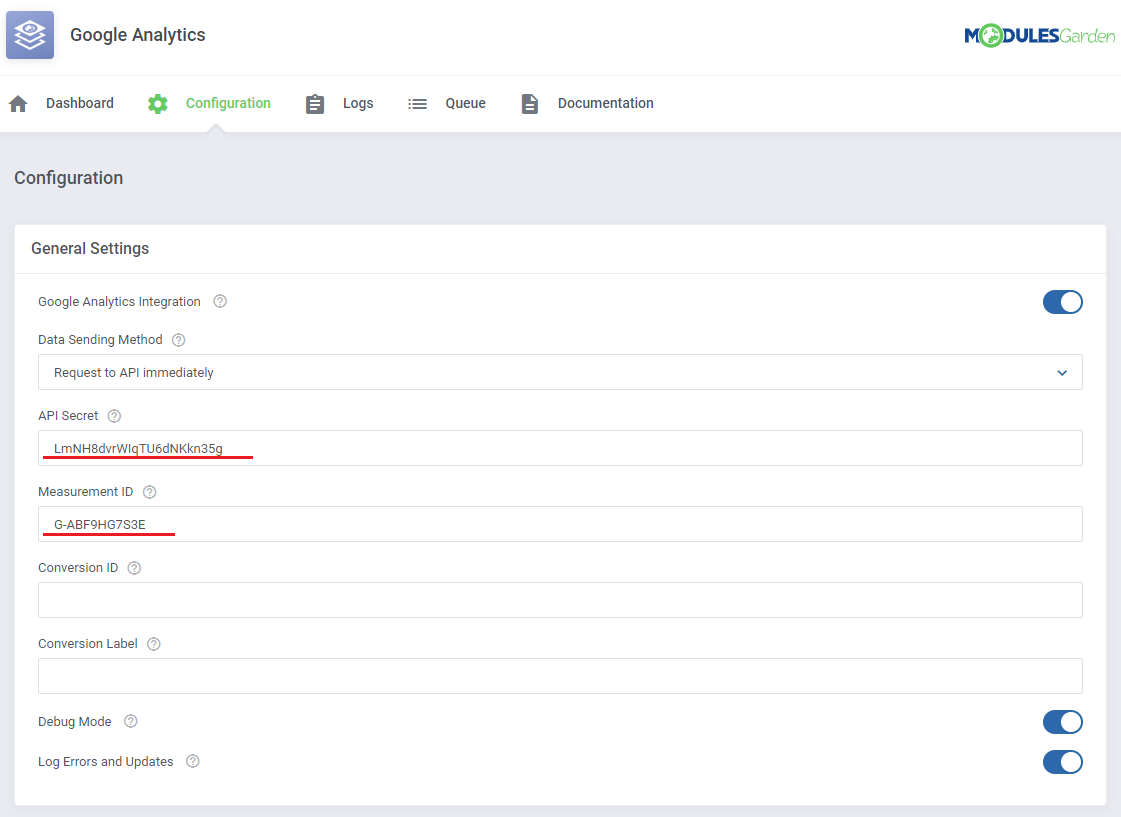
|
| 10. Go to 'Property details' and find the 'Property ID' . |
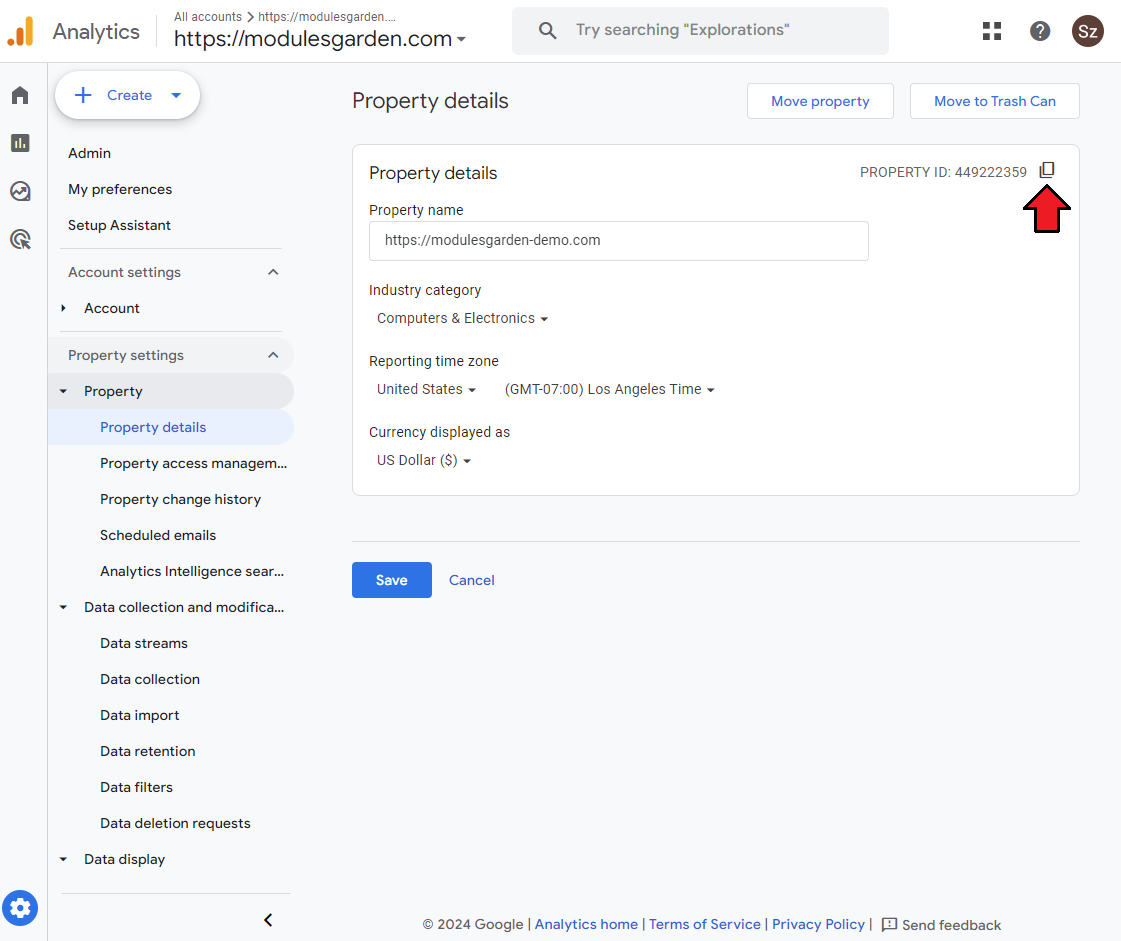
|
| 11. Copy it into the respective field under 'Dashboard' . |

|
| 12. Visit <a href="https://developers.google.com/analytics/devguides/reporting/data/v1/quickstart-client-libraries#step_1_enable_the_api" target="_blank">Google Analytics Developer Site</a>. |
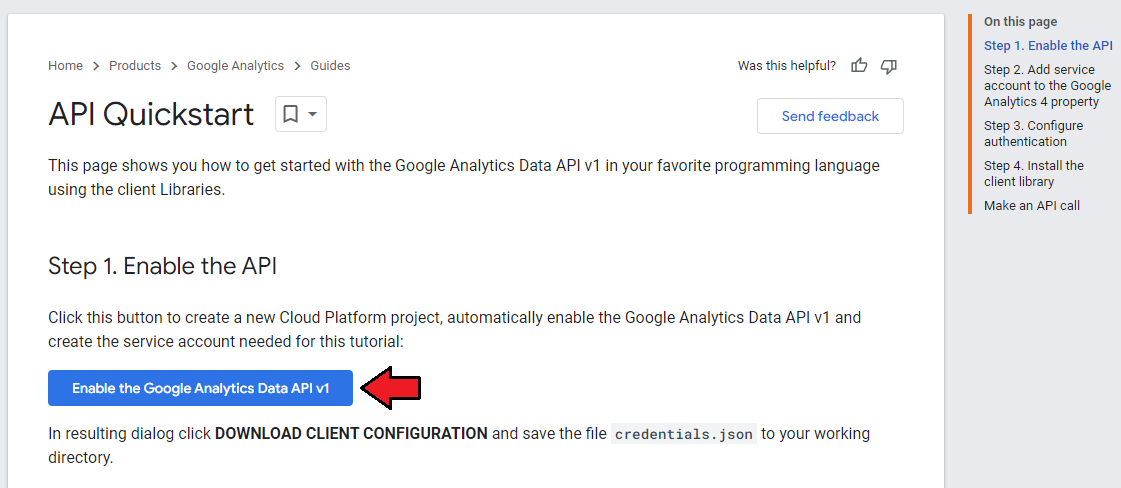
|
| 13. Click on Enable the Google Aanalytics Data API v1. |

|
| 14. Download your credentails.json file. |

|
| 15. Copy and paste its contents into the Credentials field. |
Configuration and Management
Basic Configuration
http://git.mglocal/whmcs-products/google-analytics/-/issues/32 http://git.mglocal/whmcs-products/google-analytics/-/issues/37 The API secret key is used to identify your account. You will be asked to provide one to connect to some of our services like the Google Sheets Add-on and the API functionalities. You can find your API secret key in the API page on your dashboard. You can also create new API keys in the same section if necessary."; A measurement ID in Google Analytics is a unique identifier for a web data stream (which is a website registered within Google Analytics). The format of a measurement ID in Google Analytics 4 is 'G-' followed by a combination of numbers and letters."; Log in to your Google Tag Manager account and open a container. In the top right corner (next to the Submit and Preview buttons) you'll see some short text that starts with GTM- and then contains some letters/numbers. That's your Google Tag Manager ."; The "Conversion ID" is a unique identifier assigned to a specific conversion action in Google Ads. It is used to track and report activities that lead to achieving conversion goals, such as purchases, sign-ups, or other valuable interactions. You can find it in the conversion settings in Google Ads.'; The "Conversion Label" is a unique tag assigned to a specific conversion action in Google Ads. It allows for more detailed categorization and tracking of different types of conversions, such as various products or services. You can configure it in the conversion settings in Google Ads to better understand the effectiveness of your ad campaigns.'; Debug Mode allows you to preview the content and queries directly in Google Analytics in the Debug View tab without passing them to reports.'; Log Errors and Informations allows you to monitor queries sent to Google Analytics and view their content and possible errors.'; To determine a Google Analytics 4 property Id you need to visit Google Analytics, select Admin, the Property and then property Settings. If the Property Settings shows a numeric "PROPERTY ID" such as "123...", this is the numeric Id of your Google Analytics 4 property.';
Dashboard
Logs
Queue
Tips
http://git.mglocal/whmcs-products/google-analytics/-/issues/21 Update Instructions
Upgrade Guide
Common Problems
|
